Affiliate disclosure: This post may contain affiliate links. Please see our Privacy Policy.
Fermented turmeric is a natural anti-inflammatory, and the fermentation process makes the compounds more bio-available than regular turmeric.
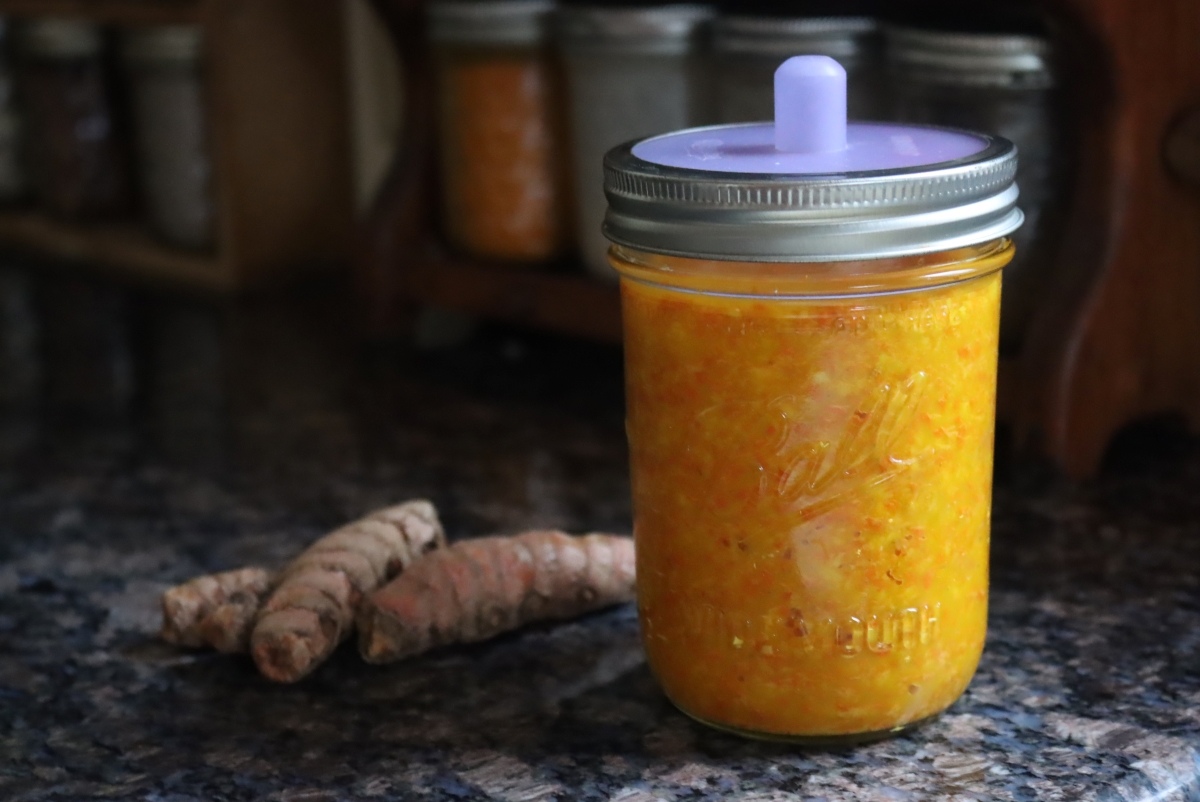
Turmeric gets a lot of attention in natural health circles for its anti-inflammatory properties, but for maximum benefit, the turmeric must be fermented. Natual probiotics help to make the anti-inflammatory compounds more bio-available, which means you get the most possible benefit.
There are a number of fermented turmeric supplements on the market, namely this one from My Kind Organics that my doctor recommended when I was having some joint pain. The problem is, they’re pretty expensive, and I decided to make my own fermented turmeric.
Fresh turmeric itself is expensive too, selling for around $20 to $25 per pound. We happen to grow turmeric at home in containers and have for years.
It’s prolific, and we harvest it by the bucket load, so making fermented turmeric at home just makes sense.
(If you don’t grow your own turmeric or have access to it at a local organic grocery, you can buy a box of fresh turmeric root online for this project.)
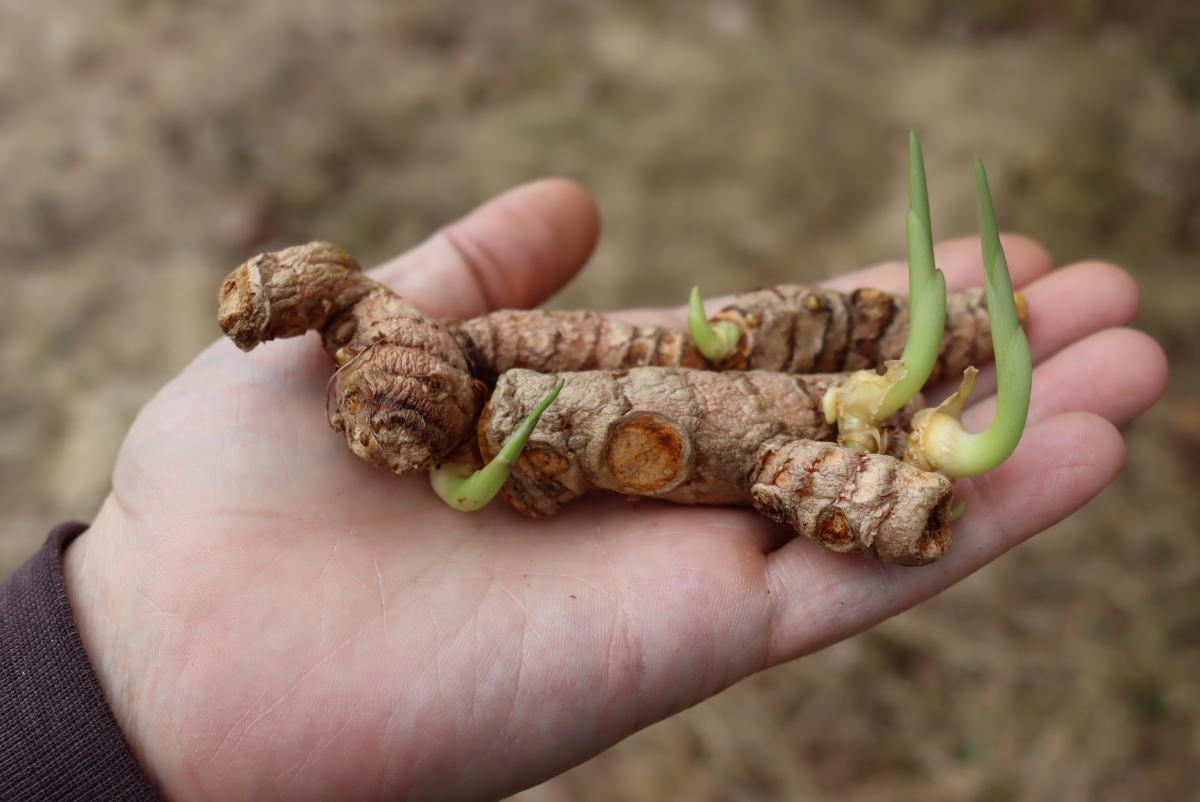
How to Make Fermented Turmeric
The book Fermented Vegetables has instructions for making fermented turmeric paste starting with:
- 1/2 pound fresh turmeric
- 1/2 teaspoon black pepper
- 1/2 teaspoon sea salt
(You can also use equal parts fresh ginger and turmeric for a mixed ferment with both flavors included.)
Gather your ingredients and start by chopping the turmeric into manageable pieces. If you’d like, you can peel the turmeric, but I’ve had better results leaving the turmeric unpeeled.
The peels are a natural source of the cultures used in this ferment, and it doesn’t get off to as vigorous a start without them.
That said, peeling the turmeric results in a cleaner flavor, and the peels can have a bit of off-flavor.
If you choose to peel the turmeric, I’d suggest inoculating the ferment with a tablespoon of sauerkraut juice, fresh yogurt whey, or the contents of a living probiotic capsule. (I’ve used these probiotic capsules as a starter in the past with success.)
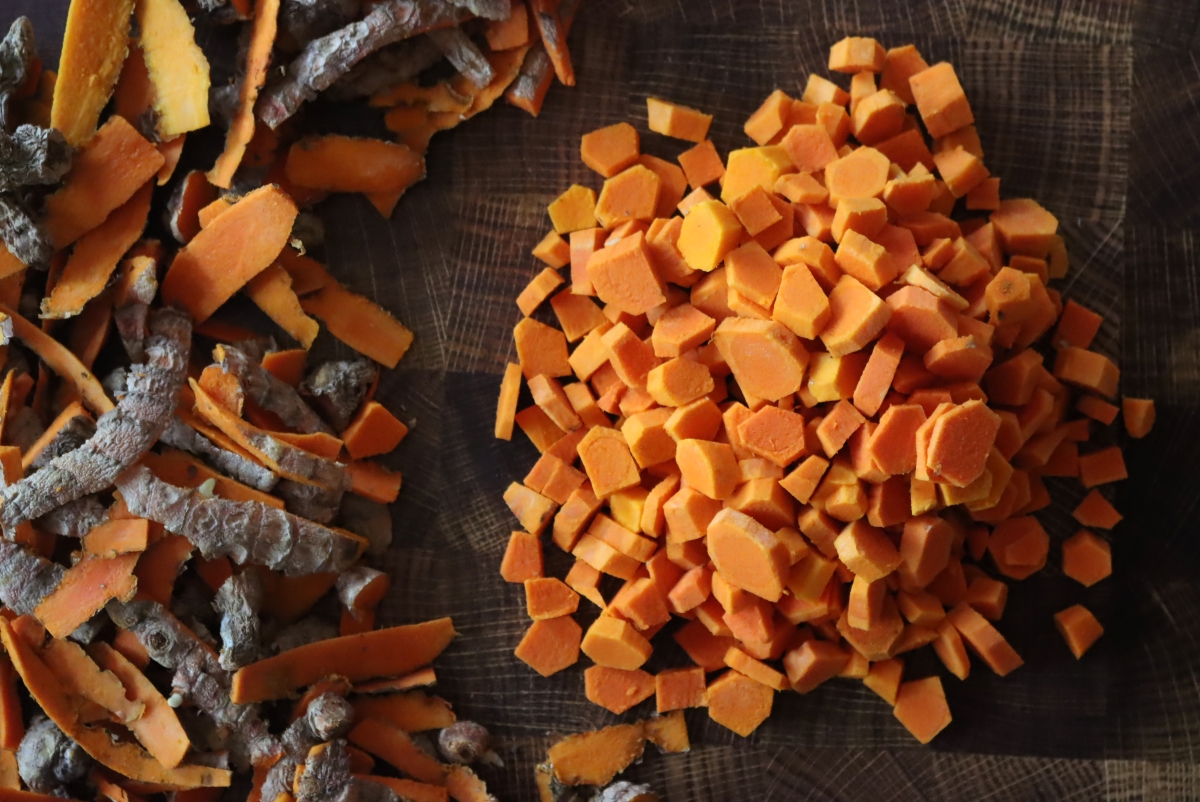
Pulse the mixture in a food processor until it’s pureed into a paste. Then press the mixture into a small glass jar. This recipe should make a 1/2 pint, but you can double it for a pint jar.
The turmeric will release liquid which should cover the solids in the puree. Anything above the liquid brine is likely to mold and spoil, so you’ll need to keep everything submerged.
Use a glass fermenting weight or a ziploc bag filled with water to hold everything under the brine.
A water lock is optional but helps ensure success. I’m using a mason tops silicone water lock kit, which also comes with glass fermentation weights so you have everything you need to get going in a wide mouth mason jar.

Allow the turmeric paste to ferment for 5-10 days at room temperature.
Once fermentation is complete, remove the water lock and tamp the turmeric paste down to ensure it’s below the brine. Cap with a regular lid and store in the refrigerator.
Properly fermented turmeric paste will keep for 12+ months in the refrigerator. Be sure to use a clean implement to scoop out spoonfuls when you go to use it so you don’t contaminate the jar.
I use fermented turmeric anywhere I’d use regular turmeric, and you can dollop a tablespoon into a homemade curry for a burst of flavor.
We’re especially fond of it for making golden milk chai with a spoonful or two of turmeric, and then a bit of ginger, cardamom, cinnamon, and honey.
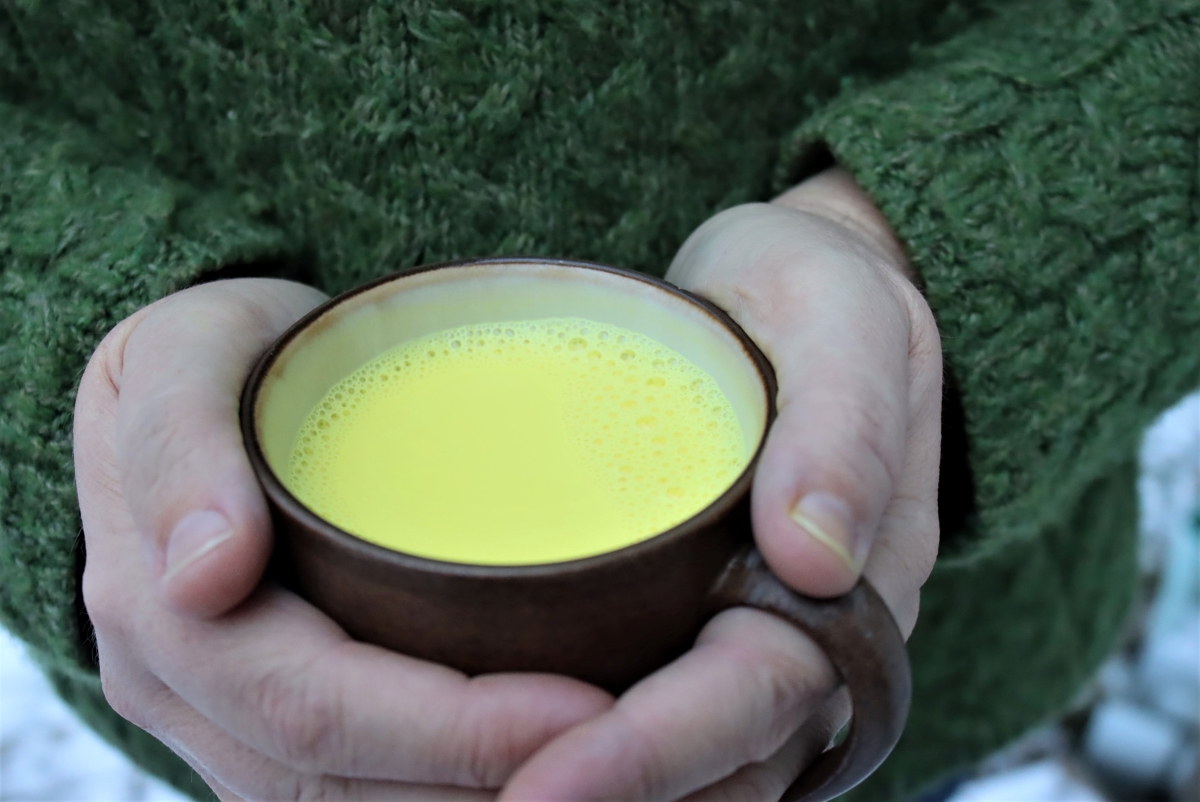
Other Ways to Make Fermented Turmeric
The method described above makes lacto-fermented turmeric, which encourages the same microbes that are responsible for yogurt and sauerkraut. You can also ferment turmeric with other probiotics for very different results.
Instead of adding salt (which promotes lactic acid bacteria), you can add a tablespoon or two of honey or sugar. That’ll promote yeast-based fermentation, generating a small amount of alcohol, but still fermenting the turmeric to both help preserve it and make the anti-inflammatory compounds more bio-available.
Turmeric kombucha is a fizzy drink made with a kombucha scoby, and turmeric water kefir is similar, but less sour and more soda-like.
My friend Colleen makes a turmeric bug, which is a simple culture like a ginger bug, and uses it to make natural turmeric soda.
Homemade Ferments
Looking for more ways to keep your kitchen bubbling?
- How to Make Sauerkraut
- How to Make Apple Cider Vinegar
- How to Make Small Batch Wine
- How to Make Mead (Honey Wine)
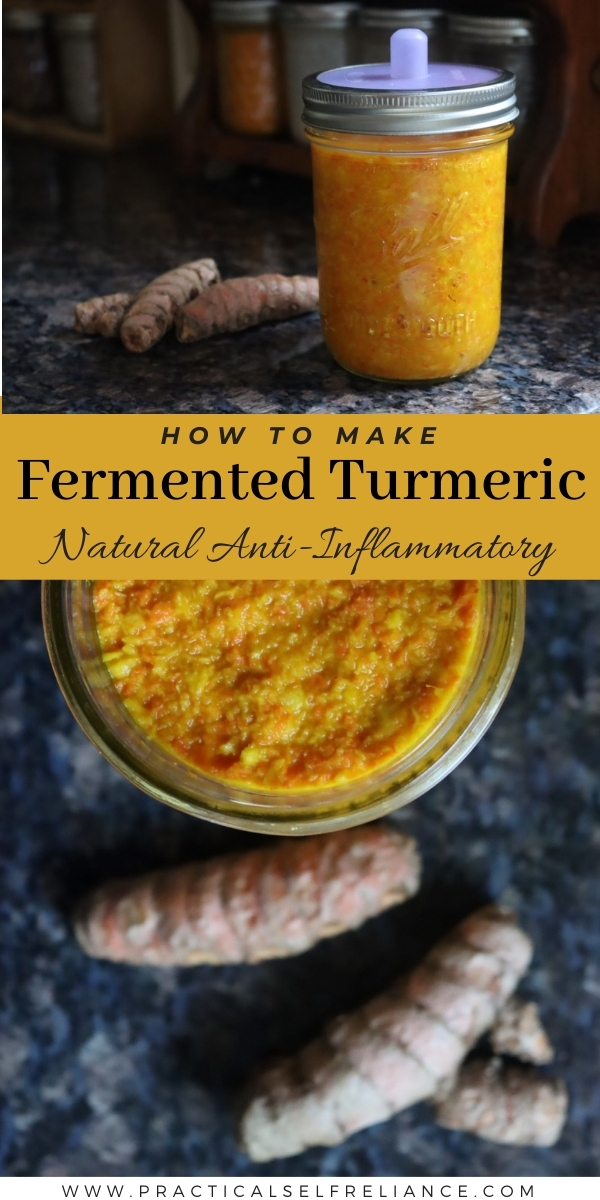


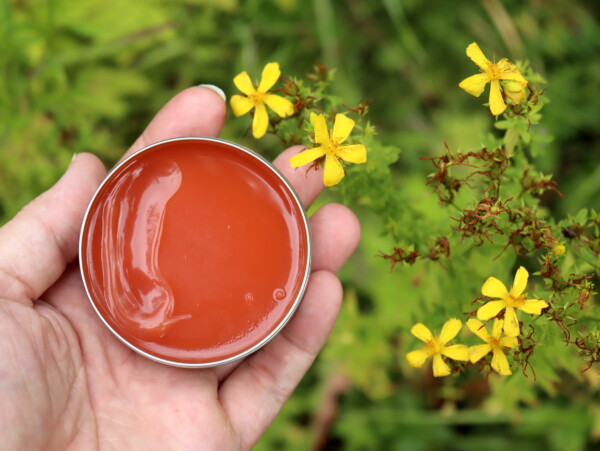
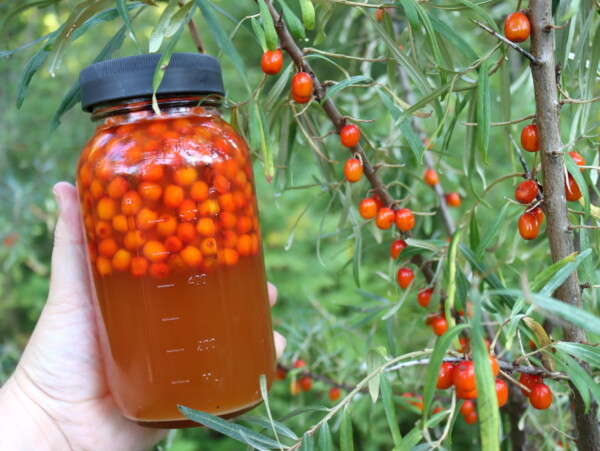










Another fermented Turmeric root method is using a small amount of pink salt and as much home-made kefir whey liquid as needed. grind the turmeric and keep it submerged in whey. This is a great low salt method. Adding a little raw honey as mentioned also increases probiotics. I add the pepper when serving and not during the ferment.
hello,
Should I increase the amount of salt if I use 1/2 lb of ginger?
If you’re just substituting the ginger for the turmeric then I would use the same amount of salt. If you’re wanting to use 1/2 of ginger and 1/2 pound of turmeric then you would essentially be doubling the recipe so I would double the salt and pepper as well.
Oh my word, this is so stinky and yet so delicious in recipes! I used half ginger, half turmeric, and fermented on the counter with a mason top – it took about 5 days to stop bubbling.
I made golden milk with it, and I’m hooked now on fermented turmeric. 🧡
Wonderful! So glad you enjoyed it!
The way the authorities prove it with beneficial bacteria is through its low PH
but in the case of turmeric how do you bring down the PH ?
Fermentation is what brings the pH down.
I followed your recipe and let it ferment for 10 days. Some Kahn yeast formed so I scraped that off and transferred to a clean container to store in the fridge. I noticed that the turmeric paste is very dry. Is that ok? Did it even ferment properly without more liquid? I realized that the liquid was on the top during fermentation and not the bottom of the jar.
It’s ok provided it’s below the liquid line. Even if it’s sort of a dry-ish paste at the bottom, so long as there’s a liquid layer over the top. Keep it submerged in liquid during storage too.
I’m not getting any liquid brine after 5 days? No brine to see. It was pureed and it was not very ‘pasty’ but I figured it would release. I have a glass weight on it. Please help, I don’t want to have it go mouldy.
Did you use the peels or did you take them off?
Yes I used the peels. I feel like some liquid, extra is needed to make the process happen, or more of something (saltor…) to make the Tumeric sweat.
You could certainly try adding some additional liquid if you feel like it would be beneficial.
I make fermented pickles in a salt brine. If you don’t have liquid over the turmeric you may try mixing some sea salt or pickling salt in water, add it to your mixture so that you have liquid over the top of your turmeric to keep it from molding. It shouldn’t take much to bring the level up.
Hello, and thank you. I’ve never tried fermenting anything, but have recently discovered the benefits of fermented tumeric, mushrooms and beets. Firstly, how much ginger should I use when making the fermented tumeric (1/2 pound) and do you have a recipe for fermented beets? I really appreciate you taking time to answer.
Melinda Biwen
You can use equal parts of ginger and turmeric. We actually don’t have a recipe for fermented beets but we do have a pickled beet recipe.
I wish I clicked “Notify” on my previous comment post? 🙁
I have replied so you can go look at it now.
when you say the skin is important to the ferment, is that because of soil bacteria on the skin? Are you washing your tumeric before you ferment? Thank you! Awesome recipe!
You’re welcome. So glad that you enjoyed the post. The ferment takes off better when the peels are left on because of the cultures that exist on the surface of the skin.
But do you wash the turmeric with the skin on?
We actually like to leave the peels on because the peels are a natural source of the cultures used in the ferment.
I KNOW you leave the peels on!!! You say that in the post, but You didn’t answer the question!
Do you WASH the turmeric WITH THE PEELS ON or do you just brush the dirt off?????
I apologize but the way the question was worded seemed as if you weren’t asking if you were supposed to wash it or not but rather if you were supposed to wash it with the peels on. You would be amazed at how many people ask questions that are specifically stated in the post. Typically the turmeric is washed at harvest time before it is stored. If this is the case then you would not need to wash it but if you are making this recipe immediately after harvesting then yes I would personally wash it before proceeding with the recipe. I would never recommend beginning a recipe without washing the dirt off first but that’s totally up to you.
Hi. So no water in the brine just add salt and pepper?
You shouldn’t need to add any water since the turmeric will release liquid on its own to make the brine. If you find that the brine is not enough to completely cover the turmeric you can add a bit of water to cover.
Hi Ashley! I LOVE all the sharing you do…and I love that you recommend so many wonderful things that you grow and use yourself…thank you so much for all the fabulous information! I am looking forward to growing some of my own Turmeric! And, then trying fermentation as well…thanks again. blessings to you and your family! Barbara from Sydney xoxoxo
You’re quite welcome! I’m so happy it’s helpful to you =)
Do you think this would work from ground organic turmeric?
I think it probably would, but I’ve never tried it. You’d likely need to seed it with culture to get it started. The dried turmeric is pretty sterile (or so I assume) and doesn’t have all the probiotics on the surface that raw fresh turmeric does. You could use a bit of sauerkraut brine or yogurt whey, about a tablespoon maybe. You can also use a probiotic capsule, just break it open and pour it in.
Since it’s dried, you’d also need to add a good bit of water to turn it into a slurry first too.
So… How much do you use ? What’s the taste like? I have joint pain, do not like to take IBPROFIN of any meds if possible. Where can I find this info?
You would just use this paste just like you would use regular turmeric. It’s not really something that you would take all by itself but instead something that you would incorporate into recipes so the taste will vary greatly depending on what you’re using it for. Here is a recipe for an anti-inflammatory golden tea made with turmeric. https://www.elizabethrider.com/how-to-make-golden-milk-recipe/ Or you can make a simple tincture instead.